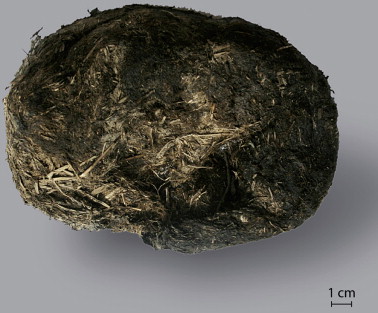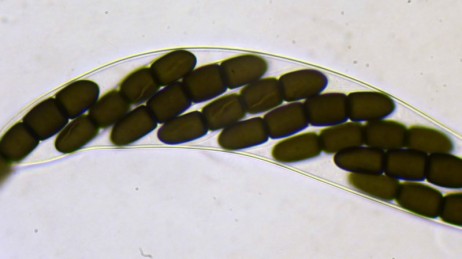Mammoth Poo Fungi
How many times have I caught my dog eating his own excrement? He always tries to lick me with that fresh brown smile. My dog’s not the only one doing it, either. Many animals chow down from time to time on their own poo: termites, rodents, rabbits… even woolly mammoths ate their own poo.
 How do we know this? Mammoths have been extinct for thousands of years. We know because scientists found a fungus, Podospora conica, deep inside this dung ball (right).1,5 This poop looks almost fresh, but is about 14,000 years old and was found among remains of a woolly mammoth in northwestern Alaska. Podospora is a tiny, dark fungus that looks a lot like this. Since it only fruits on the surface of poo some time after it’s been pooped, the only way it could’ve gotten into the center of a mammoth nugget is if a mammoth had enjoyed a tasty number two snack.
How do we know this? Mammoths have been extinct for thousands of years. We know because scientists found a fungus, Podospora conica, deep inside this dung ball (right).1,5 This poop looks almost fresh, but is about 14,000 years old and was found among remains of a woolly mammoth in northwestern Alaska. Podospora is a tiny, dark fungus that looks a lot like this. Since it only fruits on the surface of poo some time after it’s been pooped, the only way it could’ve gotten into the center of a mammoth nugget is if a mammoth had enjoyed a tasty number two snack.
Podospora belongs to a diverse group of fungi called coprophiles (a word that means “poo lovers” but sounds more scientific). You’ve already read about another famous coprophile, Pilobolus, here on the Mushroom Blog. Coprophiles live on poop, especially the poop of herbivores which contains lots of partly-digested, but still nutritious plant matter. Take a moment to imagine the difficulties of living on a piece of poop, and needing to get your offspring onto a new piece of poop. There’s more than one way to do it, but a popular choice among coprophiles is to shoot spores onto nearby vegetation,2 and hope they get eaten by a herbivore like a woolly mammoth. The spores then pass through the digestive system and find themselves in a fresh piece of poop, where they begin to grow. The fungus eats the poop for a while, then is confronted by the same problem: how do I get my offspring to new poop? So the fungus produces fruiting bodies on the surface of the poo, and off we go again. That’s what coprophiles do, and that is ALL they do—their whole world is crap.
Feeding on excrement is called coprophagy, and is not uncommon in the animal kingdom. Re-digesting feces can be a valuable way to get nutrients synthesized by an animal’s intestinal bacteria, like vitamins K, B12, and B7. The community of fungi that lives on poo might also release additional nutrients. Young elephants consume the feces of adults—apparently to obtain the bacteria they need for their own guts. Some animals practice coprophagy regularly; others do it out of desperation. Maybe it’s a harsh winter and food is scarce? Dogs are another question—I’m pretty sure they just do it to gross us out.
 Sure, fungi can answer the burning question: did mammoths eat their own poo? But they might also shed light on mammoth extinction. Woolly mammoths were one member of the extinct genus Mammuthus and were found in Europe, Asia, and North America. In North America, mammoths died off around 12,900 years ago during the quaternary extinction event. Many other large mammals (our megafauna) died off then too. Why? Maybe it was climate change. Perhaps it was an impact from an extra-terrestrial object that led to sudden changes in climate.4 Scientists can’t quite agree about this. As a member of the human race I am more than happy to let the asteroid take the blame, but unfortunately another hypothesis is that ancient humans killed off the mammoths.
Sure, fungi can answer the burning question: did mammoths eat their own poo? But they might also shed light on mammoth extinction. Woolly mammoths were one member of the extinct genus Mammuthus and were found in Europe, Asia, and North America. In North America, mammoths died off around 12,900 years ago during the quaternary extinction event. Many other large mammals (our megafauna) died off then too. Why? Maybe it was climate change. Perhaps it was an impact from an extra-terrestrial object that led to sudden changes in climate.4 Scientists can’t quite agree about this. As a member of the human race I am more than happy to let the asteroid take the blame, but unfortunately another hypothesis is that ancient humans killed off the mammoths.
The first human settlers arrived on the North American scene 13,000ish years ago. Most came via a land bridge from Russia to Alaska, others perhaps by sea.6 Mammoths liked to eat poo; humans liked to eat mammoths, and they hunted them during the Pleistocene era and up until their extinction. Maybe they ate them all, or persecuted them enough that their populations crashed. So who gets the blame? Who would have thought a fungus might have the answer? A fungus that eats mammoth crap!
 Scientists are using Sporormiella spores to study the prevalence and extinction of the woolly mammoth.3,4 Sporormiella species are coprophiles that, like Podospora, travel through a herbivore to complete their life cycles. In times when Sporormiella was very abundant (poopy landscape), a count of its spores in sediment cores can give an indication of just how poopy the landscape was.
Scientists are using Sporormiella spores to study the prevalence and extinction of the woolly mammoth.3,4 Sporormiella species are coprophiles that, like Podospora, travel through a herbivore to complete their life cycles. In times when Sporormiella was very abundant (poopy landscape), a count of its spores in sediment cores can give an indication of just how poopy the landscape was.
Sporormiella spores are tough-walled and have a distinctive four-celled structure–each cell is marked by a “germ slit” like a papercut in the brown spore wall. There are many Sporormiella species and they aren’t specific to a particular herbivore’s dung. Each spore measures around 50 micrometers long–imagine trying to find these tiny specks in dark brown sediments. Researchers collected samples at various sediment depths in an Indiana lake, and counted the Sporormiella spores. Each sample depth correlates to a precise period of time. When the numbers came back the scientists were surprised: They found a decline in the number of Sporormiella spores starting almost 15,000 years ago, before any human interference or asteroid impact. Spore levels had declined to 2% of their former number by around 13,700 years ago.3 The decline suggests a population collapse but not a final extinction. This time frame roughly coincides with a period of warming before the asteroid collision. Perhaps humans weren’t fully to blame if mammoths were struggling before humans got there. It looks as if multiple factors are behind the extinction.
That a spore that measures five one-hundredths of a millimeter could be an reliable indicator of a six ton mammal that lived more than 13,000 years ago is pretty incredible. There’s some friendly debate about how far one can go with this approach, but there’s no question that fungi can be important clues to the past.7 I say, next time you pass by a pile of turd, show a little respect, it may be more important than you think.
References:
- van Geel, B., R.D. Guthrie, J.G. Altmann, P. Broekens, I.D. Bull, F.L. Gill, B. Jansen, A.M. Nieman, B. Gravendeel. 2011. Mycological evidence of coprophagy from the feces of an Alaskan Late Glacial mammoth, Quaternary Science Reviews, Volume 30(17–18): 2289–2303. doi:10.1016/j.quascirev.2010.03.008
- Deacon, J. W. (1997). Modern mycology. Oxford: Blackwell Science. p. 166. ISBN 0-632-03077-1
- Gill, J. L., Williams, J. W., Jackson, S. T., Lininger, K. B., & Robinson, G. S. 2009. Pleistocene megafaunal collapse, novel plant communities, and enhanced fire regimes in North America. Science, 326(5956): 1100-1103. doi:10.1126/science.1179504
- Mason, B. 2009. Dung fungus provides new evidence in mammoth extinction. Retrieved April 2013 from Wired Science.
- Reilly, M. 2010. Mammoths ate their own poo. Retrieved April 2013 from NBCnews.com.
- Maugh, T. H. 2012. Who was first? New info on North America’s Earliest Residents. Los Angeles Times, July 12 2012.
- A.G. Bakera, S.A. Bhagwatb, K.J. Willis. 2013. Do dung fungal spores make a good proxy for past distribution of large herbivores? Quaternary Science Reviews 62: 21–31. [this is a nice paper! –Ed.] doi:10.1016/j.quascirev.2012.11.018
Image Sources:
- A piece of mammoth poop. Dung ball with Podospora inside recovered from mammoth remains near Cape Blossom, Alaska. Photo Credit and Copyright: Dr. Bas Van Geel (1).
- Woolly mammoths, excerpted from a painting by Mauricio Anton. I think the third one is pooping, don’t you? Via Wikimedia Commons.
- Eight spores of Sporormiella australis inside an ascus. Photo by Björn Wergen of a modern-day Sporormiella, used with kind and explicit permission.


Great science writing – I learned a lot and wanted to keep on reading about the subject. I also passed your post on to several high school and middle school bio teachers I know here in Maine and in Ithaca – just the kind of poopy article that will keep kids reading and get them fascinated with the subject. You may spawn a few mycologists with this, who knows! Keep on writing.
A superb blog posting that, like all good mycological writing, is open-ended (sorry for the pun) — maybe mammoth coprophites can help us determine what happened on our planet ca. 13,000 years ago…or maybe not. Likewise, it shows that if you want to make a mycologist happy, give him/her shit…
L. Millman
Very interesting article, thanks!
Due to my passion for fungi foraging and lifelong interest in N American archaeology, this was right up my alley. However, I do have to take issue with a certain data point you’ve issued as a fact, which is actually no longer considered a fact by the experts in the field: 13,000 years ago was not the first occupation of the Americas. Essentially, this is the “Clovis First” hypothesis, which has now been pretty convincingly debunked by findings at multiple sites throughout N & S America, which clearly show human habitation far before 13,000 years. It appears likely that there have been multiple migrations of humans from modern day Asia and perhaps even Europe (Solutrean) that date back as far as 50,000 years. I worked on one such site during my teenage years with Dr. Al Goodyear and team in Allendale County, SC (http://allendale-expedition.net/). So, perhaps it was indeed an increase in populations of mammoth-munching humans in combination with other environmental stressors that ultimately led to the extinction of mammoths and other N American megafauna.
Here’s a nice related story from the field. Scientists search for evidence of the last mammoths of St. Paul Island, where they survived longer than they did elsewhere. They’re on the hunt for Sporormiella and other clues: http://blogs.discovermagazine.com/fieldnotes/?p=159